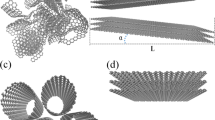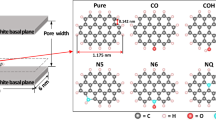Abstract
In order to clarify whether static electricity can impose a control on physical adsorption of polar adsorbates, MD simulations were carried out to study the adsorption/desorption behavior of methanol in the nanopores of electrified activated carbon fiber (ACF). Some special phenomena were observed from the MD simulations for methanol adsorption in a mesopore of electrified ACF. For example it takes a shorter time for the adsorbates to reach the adsorption sites on the mesopore wall, the liquid-like methanol is highly condensed, the methanol molecules have a unique distribution of space orientation, and the total energy of equilibrium state dropped a lot. These phenomena indicate the static electricity reinforced the interaction between the polar methanol and the electrified ACF, so that the intensity, stability and regularity of adsorption were increased, and thus we predict that the adsorption capacity will be increased and the adsorption process will be accelerated. When adsorption equilibrium was reached at room temperature, eliminated the electric charges and heated the system, the desorption tendency was evidently observed from our simulations at 60°C or so.
Similar content being viewed by others
References
Wang, R. Z., Jia, J. P., Teng, Y. et al., A potential solid adsorption refrigeration pair—active carbon fibermethanol. Acta Energ. Solar. Sinica (in Chinese), 1997, 18(2): 222–227.
Wang, R. Z., Wu, J. Y., Xu, Y. X. et al., Experiment on a continuous heat regenerative adsorption refrigerator using spiral plate heat exchanger as adsorbers. Applied Thermal Eng., 1998, 18(1–2): 13–23.
Vagner, C., Finqueneisel, G., Zimny, T. et al., Isotherms and kinetics of methanol vapor adsorption on carbon fibers and activated carbons. New Carbon Materials, 2003, 18(2): 133–136.
Wang, D. R., Development and application of activated carbon nanofiber, Carbon (in Chinese), 2003, 1: 35–41.
Su, J. C., Qiu, J. Sh., Preparation of activated carbon fiber-based composite adsorbent and its gas separation performance. Carbon Techniques (in Chinese), 2001, 3: 1–4.
Gasteiger, J., Marsili, M., Iterative partial equalization of orbital electronegativity—a rapid access to atomic charges. Tetrahedron, 1980, 36: 3219–3288.
Cornell, W. D., Cieplak, P., Bayly, C. I. et al., A second generation force field for the simulation of peoteins, nucleic acids, and organic molecules, J. Am. Chem. Soc., 1995, 117: 5179–5197.
Ewald, P. P., Die Berechnung optischer und elektrostatischer gitterpotentiale, Ann. Phys., 1921, 64: 253–287.
Allen, M. P., Tildesley, D. J., Computer Simulation of Liquids, Oxford: Oxford University Press, 1987, 157–162.
Leach, A. R., Molecular Modelling: Principles and Applications, London: Addison Wesley Longman Limited, 1996, 294–298.
Author information
Authors and Affiliations
Corresponding author
Rights and permissions
About this article
Cite this article
Liang, S., Xu, J. Methanol adsorption studies of electrified ACF by MD simulations. Sci. China Ser. E-Technol. Sci. 47, 667–675 (2004). https://doi.org/10.1360/03ye0573
Received:
Issue Date:
DOI: https://doi.org/10.1360/03ye0573




